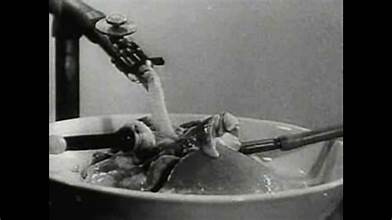Reanimators: When Science Played God
Reanimators | When Science Played God
Experiments in the Revival of Organisms
In the eerie silence of post-WWII Russia, behind the iron curtain of secrecy, a group of Soviet scientists dared to play God. Led by Sergei Brukhonenko, they launched grotesque yet groundbreaking experiments that shook the very definition of life and death.
Their laboratory was not a place for the faint-hearted. Blood pumps hissed, scalpel blades glinted under the harsh lights, and the air reeked of antiseptic and ambition. The mission? To bring the dead back to life—not in theory, but literally.
Using a machine called the autojektor—a crude heart-lung machine—they managed to revive a severed dog’s head. Yes, you read that right. A head. No body. Still alive. The dog responded to sounds, blinked, and even licked its nose when acid was dripped on it.
In another dog bp experiment, scientists drained blood until the animal died. Minutes later, they pumped it back in—and astonishingly, the creature gasped, jerked, and resurrected like an undead lab hound. It walked, barked, and wagged its tail—though witnesses claimed its eyes looked emptier, as if it had seen something no living creature should.
 Echoes from the Soviet Revival Lab
Echoes from the Soviet Revival Lab
Hidden in wartime secrecy, a Soviet lab in 1940 captured chilling experiments. The infamous autojektor sustained severed dog heads and even reanimated recently deceased animals. The footage is raw: heads blink, tongues flick, paws twitch—they lived without bodies, suspended by tubes and pumps.
Other dogs, drained of blood, were revived minutes later—an unnatural dance between science and death. This laid the groundwork for ideas later revisited in projects like the two headed dog experiment, which further blurred the line between scientific innovation and horror.
Interesting Facts & Dark Speculations
-
Pioneering ECMO – The autojektor predates modern ECMO (extracorporeal membrane oxygenation) machines, now standard in critical care.
-
Military Ambitions – Rumors suggested military funding, perhaps to revive injured soldiers.
-
Ghosts of the Brain – Speculation grew about consciousness lingering in isolated organs, echoing fears of disembodied existence.
A Lab Like No Other
Picture this: dimly lit theaters, the hiss of pumps, stainless tables gleaming, and tubes feeding lifeless bodies. Soviet scientists pressed on, determined to prove that life was mechanical.
The autojektor revived severed heads and resurrected whole dogs minutes after death. These creatures, once clinically gone, stood again—though their spirit seemed altered.
The Isolated Head
Perhaps the most disturbing sequence involved an isolated dog’s head:
-
Snipped clean from the body, attached to tubes.
-
Eyes blinked.
-
Tongue flicked.
-
The head responded to air and acid stimuli.
It was an anatomy lesson unlike any found in books on the anatomy dog skeleton—a grim showcase of biology and machine working in tandem.
 Defying Finality: Death Reversed
Defying Finality: Death Reversed
Entire dogs, declared dead, were brought back:
-
Hearts restarted.
-
Breathing resumed.
It raised new debates—not only about science, but about what truly defines being alive.
Facts Behind the Fear
-
Cross-National Interest – Though Soviet-led, Americans observed the work.
-
Precursor to ECMO – Nearly 30 years ahead of its time.
-
Ethical Questions – Animal suffering was disregarded, sparking debates still relevant today.
-
Survival vs. Quality – Some revived animals seemed “haunted,” unable to return fully to normal.
Even skeptics could not dismiss the sheer strangeness of the footage.
Fascination vs. Horror
For some, these experiments were medical milestones. For others, they were cruel spectacles. Questions arose about whether these tests were staged, yet most historians accept them as authentic early biomedical research.
Such grim labs could hardly be compared to a place where dogs are kept for companionship or breeding. These were facilities where animals were mere tools for scientific ambition.
Then vs. Now: The Legacy
Modern parallels are striking:
-
CPR – Standard since the 1960s, it reflects the same idea of pumping life back.
-
ECMO Machines – Extensively used during COVID-19, saving thousands by sustaining failing hearts and lungs.
-
Cryogenic Suspension – Freezing the dead in hope of future revival echoes Brukhonenko’s audacity.
-
Brain Preservation – Recent perfusion experiments in pig brains reignite the same ethical alarms.
Today, debates also cover humane practices like the benefits of neutering a dog for health and control, in stark contrast to the brutal experiments of the past.
Dogs, Ethics, and Memory
From the earliest canines believed to be the oldest known breed of domesticated dog, to the bonds we form when an animal mate dog becomes family, dogs have always held a place of loyalty and affection. The Soviet experiments exploited that loyalty in ways unthinkable today.
Final Thoughts
The 1940 Autojektor experiments were more than horror—they were a glimpse into science’s temptation to control life and death. They showed that mechanics could mimic miracles, but at what moral cost?
Suspended death, blinking eyes, wagging tails—all under sterile lights. These haunting images remain etched in history, forcing us to ask not just, “Can we?” but, “Should we?”
Disclaimer
The blog Reanimators discusses strange experiments in which scientists imagined bringing the dead back to life. Some descriptions stem from historical reports, others from speculative ideas. The purpose is curiosity and awareness, not encouragement. It should be enjoyed as a mixture of science history and mystery—not as real or repeatable medical advice.


